Finally, I have now got hold of the Panasonic GF1 with it’s Lumix 14-45mm kit lens (Thanks to my friend CW) and the latest Olympus PEN E-PL1 with it’s M-Zuiko digital 14-42mm kit lens! Now, this shall be a FAIR COMPARISON, as much as possible, as both are with their standard kit zoom lenses.
I am writing this review of comparison between the two cameras in the SIMPLEST manner I can think of, yet hopefully good enough for the layman, and even for one who has ZERO knowledge of cameras and photography, to make a clearer decision between the two, i.e. WHICH TO BUY?
NO REVIEWER IS 100% BALANCED. So, make your own conclusions!
We have to understand that both cameras’ main target audience are NOT the Professionals. The main target audience are consumers, ordinary students, daddies, mummies… and photo enthusiasts who want something small to carry with them daily… yet something that way surpasses the usual compact digital cameras’ standards in image quality and handling.
We have also seen the Micro-four-thirds cameras landing in the bag of professionals as a leisure camera, second camera or a backup camera, and some use it for work like myself, or Kirk Tuck.
BUT this review is aimed NOT at the professionals.
In this review, I shot with both cameras set to iAuto Mode. I used them in my everyday life. I shoot like an ordinary Daddy, like what every dad would want to photograph his child. I used both cameras NO DIFFERENT from any of you out there. So, the images I am gonna present here are NO GALLERY PRINTS. :p
My Workflow:
Shot with both cameras using RAW, iAuto Mode. I used them in Normal Circumstances as an ordinary guy in his everyday life, shooting in shopping centres, shooting his own kid, shooting at home and wherever he goes. All images are converted to JPGs using Lightroom Beta 3 version in default mode with no additional modification to the files at all, not even exposure, just to show you what comes out straight from the cameras.
WHY SHOOT in iAUTO MODE?
These Micro Four Thirds cameras are meant to produce amazing pictures straight off the camera without having to adjust much settings. If I want a camera to adjust it’s settings as a playtime, it would be the Nikon D700 or the Nikon D3s. There is at least 100 menu options in them to choose from. Now, at least in my personal philosophy, I expect the camera to meet or exceed my expectations at it’s so-called most intelligent “iAuto Mode”!
iAuto Mode is supposedly much better than P (Program)Mode, or in Cantonese as a joke, what we call the “PUN” Mode (basically means “idiot mode”). It’s supposed to be much more intelligent than the P Mode. Now let’s see how “intelligent” each camera behaves… … here we go… …
NOTE: All images are uploaded in the highest tolerable resolution online in this blog possible for you to download and pixel-peep. To do that, keep clicking on image till you can right click and save the high resolution file.
1. Indoor Artificial Lighting Condition – Shopping Centers (Most digital cameras suck at this)
Verdict:
Digital cameras have always got a problem with reds. There are very few digital cameras that can reproduce red accurately. As both shots were shot in iAuto Mode, white balance was AWB(auto). In this instance, Olympus over-cooked the reds and Panasonic produced more neutral colors.
2. Action Shots Indoors using iAuto Mode
Verdict:
In handling the cameras, immediately you will feel that GF1’s auto-focusing is faster and seems more decisive and definite. Initial impression is that the GF1 “found” focus and snapped the shutter much faster than the E-PL1. BUT upon scrutinizing both cameras’ files in my computer, I have found that the GF1 may have activated it’s shutter much faster and easier than the E-PL1 but to my disappointment, the hit rates are just as bad as the E-PL1! The number of “useable” images shot in iAuto mode for both cameras, chasing after running kids, are just about the same amount! We are talking about nailing the focus.
Suggested Solutions:
A. Buy a DSLR which performs well through ISO3200 and above like the latest Canon 550D which is good through ISO6400
OR
B. Use ISO1600 on either the E-PL1 or GF1 coupled with a fast lens like the Lumix 20mm F1.7. Shoot RAW and convert using Lightroom or Photoshop and you get lesser noise than direct JPGs straight out of camera.
3. Macro Test, using the minimum focus distance on each lens
Verdict:
It is quite clear that the E-PL1’s 14-42mm kit lens has a much closer focusing distance which gives higher magnification though it underexposed. But just a little exposure adjustment either in-camera when shooting or in your computer will bring it’s shine back easily!
4. i-Auto Intelligence in using In-Body Image Stabilization and Lens Optical Stabilization in lowlight conditions
Verdict:
It’s not fair to say that Olympus’s in-body I.S. is better than the Panasonic lens’s O.S. here as the iAuto mode in both cameras gave a drastic difference in ISO, which results in different shutter speeds.
But what we can see here, and from all the above examples so far is that Panasonic tends to give a lower ISO which results in slower shutter speeds. In this instance, the intelligence in the E-PL1 beats the GF1.
Panasonic should learn that it’s lens’s O.S. is not good enough for 1/8s in it’s iAuto Mode! Having this happened in iAuto Mode is quite unforgivable unless they are like the Nikon guys who expect us to dabble an hour or two with it’s menu before shooting. Unlike Olympus, I have done many shots with the E-P1 and E-P2 at shutter speeds as slow as 1/2s and achieved sharp images using it’s in-body image stabilization!
5. Daylight Photography
Now, by today’s digital photography technology standards, all cameras should already have no problems rendering DAYLIGHT images. Let’s see … …
Again, the reds are different here. Maybe it’s just “different film” we are looking at here? Which “film” do you prefer? Also, the iAuto on both cameras focused differently. But this can be done manually by “re-focusing” the camera (just let go of shutter button and press another few times till desired focus point is achieved or manually select focus point).
Digital cameras not just have a thing about the reds but also the purples. Both cameras rendered purple very differently. If we talk about reality, Olympus rendered purple as purple, much closer to the real colors. As for the Panasonic, morning glory has turned blue.
My boy wanted rain in such extremely hot season lately. Personally, I prefer the greens from the Olympus in these shots.
Next, we look at the ergonomics of both cameras.



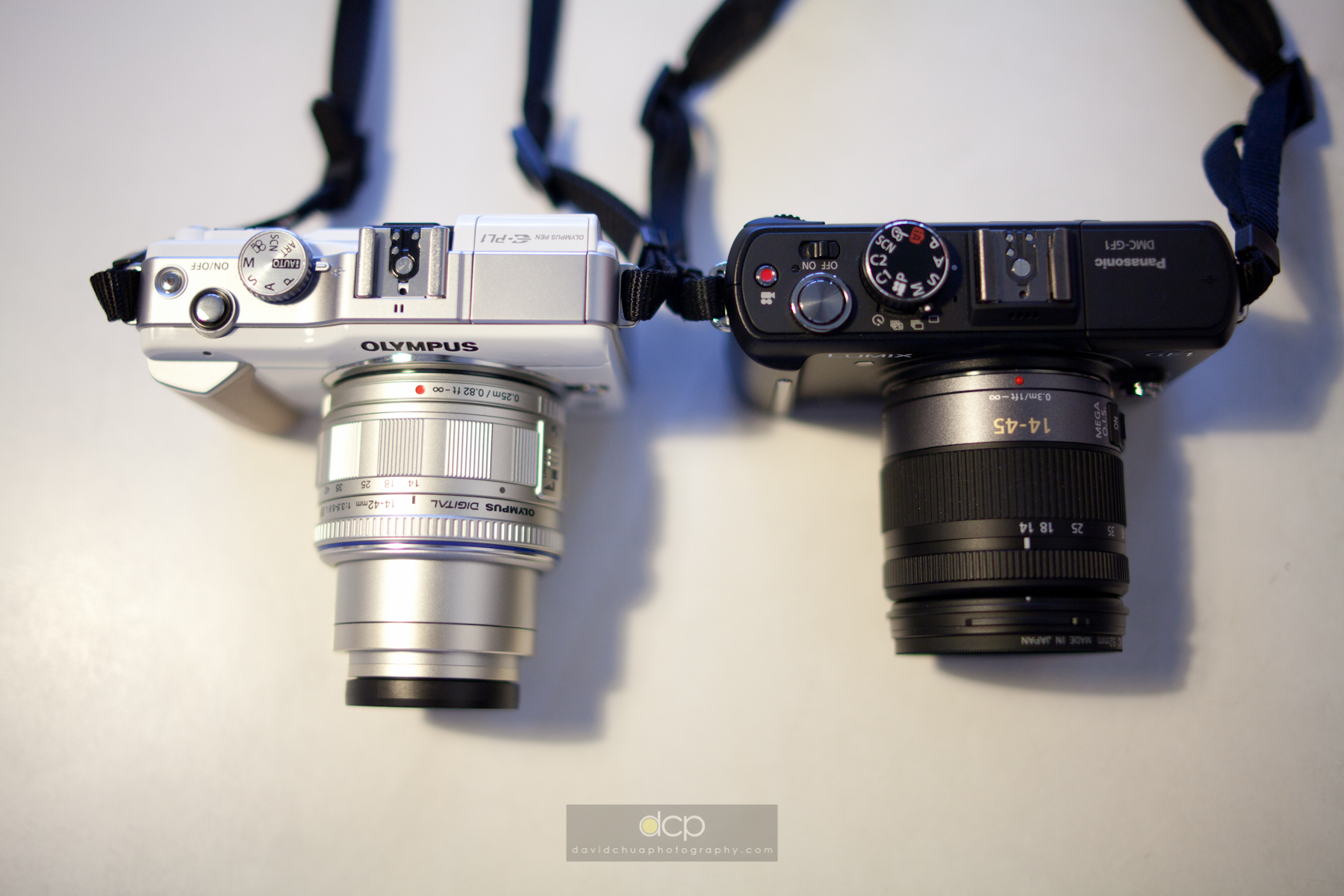
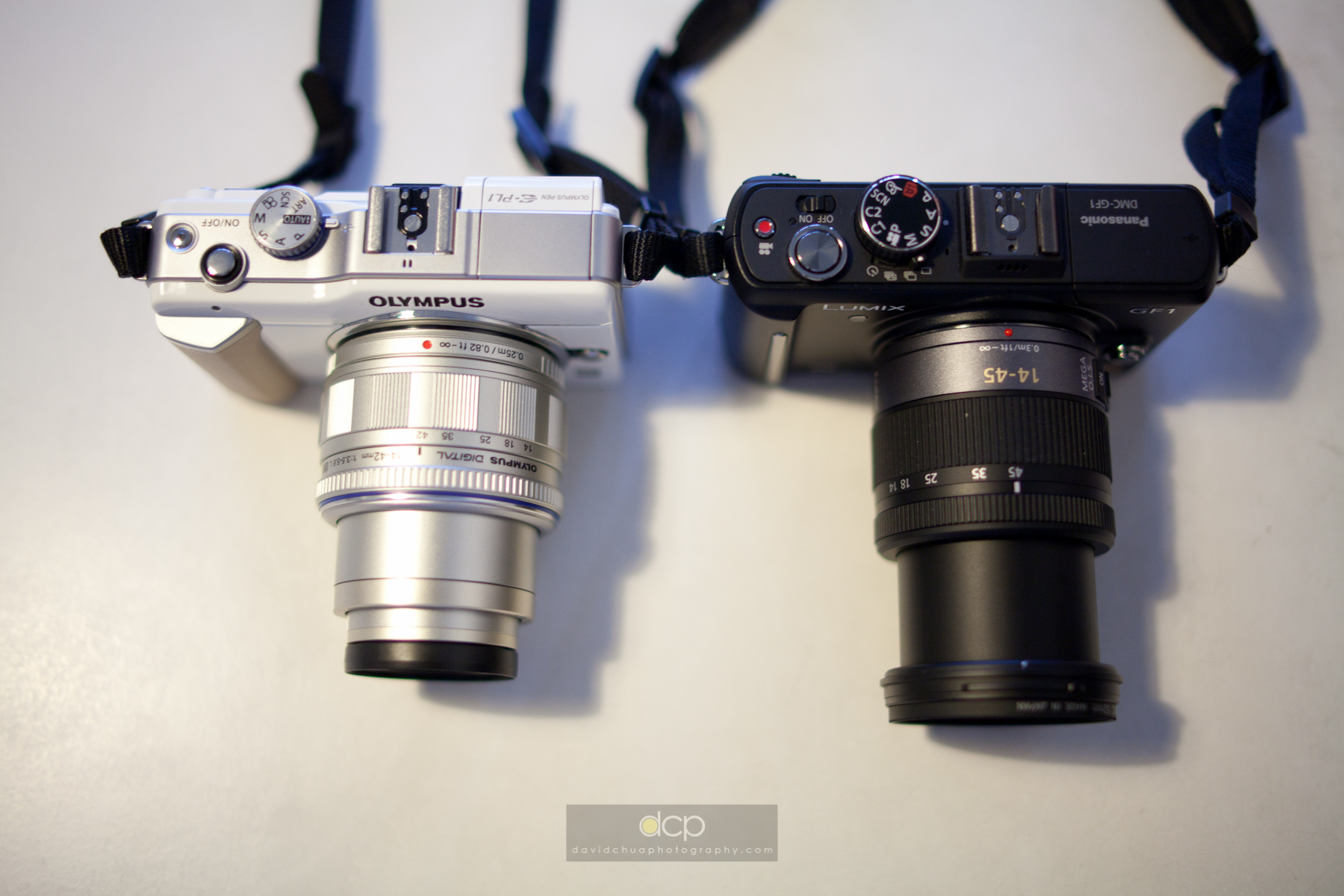
Verdict:
1. Panasonic doesn’t seem to understand the power of Micro Four Thirds is in it’s SIZE too. The pursuit of producing High Quality Cameras in the smallest size possible. Even Ricoh understood that! (Beautiful GXR!) It’s either we settle down on the size of a typical DSLR or we go really small.
2. The collapsible Olympus kit lens is even lighter than the ones that came with the E-P1 and E-P2 this time, having a plastic mount. The front element when extended still is wiggly though it does not affect it’s function at all. If you want something real solid, go for the Leicas. :p
3. The grip on the E-PL1 feels much better and more comfortable than the GF1. The GF1 is a little heavy for it’s smooth grip.
4. The shutter sound on the E-PL1 sounds nicer to me. The GF1 sounds clanky.
5. Though the GF1 seems quicker in releasing it’s shutter, results have shown it does not necessarily means nailing the focus better than the E-PL1.
Overall, the GF1 looks more classy, expensive and professional and the E-PL1 looks more plasticky BUT I personally prefer the lightweight E-PL1 and it’s overall image performance. Again, if I want something real professional, classy and small, it will be either the Leica M8 or M9.
As compared with the E-P1 and E-P2, this is what I discovered:
1. The E-PL1 is much sharper than both E-P1 and E-P2.
2. The AF on the E-PL1 is slightly faster than the E-P1 and E-P2. The AF is exceptionally fast with the NEW m-zuiko 9-18mm lens. This one I hope I can get a copy for further review at a later stage but I tried it once and it was really impressive!
3. The E-PL1 is more intelligent in handling backlit situations. It is also overall more intelligent than the E-P1 and E-P2.
I hope I have not made people more confused and all the effort I put in this post helps someone out there. 🙂 Cheers!
Bookmark me, subscribe to my blog, comment or email me to make a friend. Stay tuned for more updates very soon!
Related Posts:
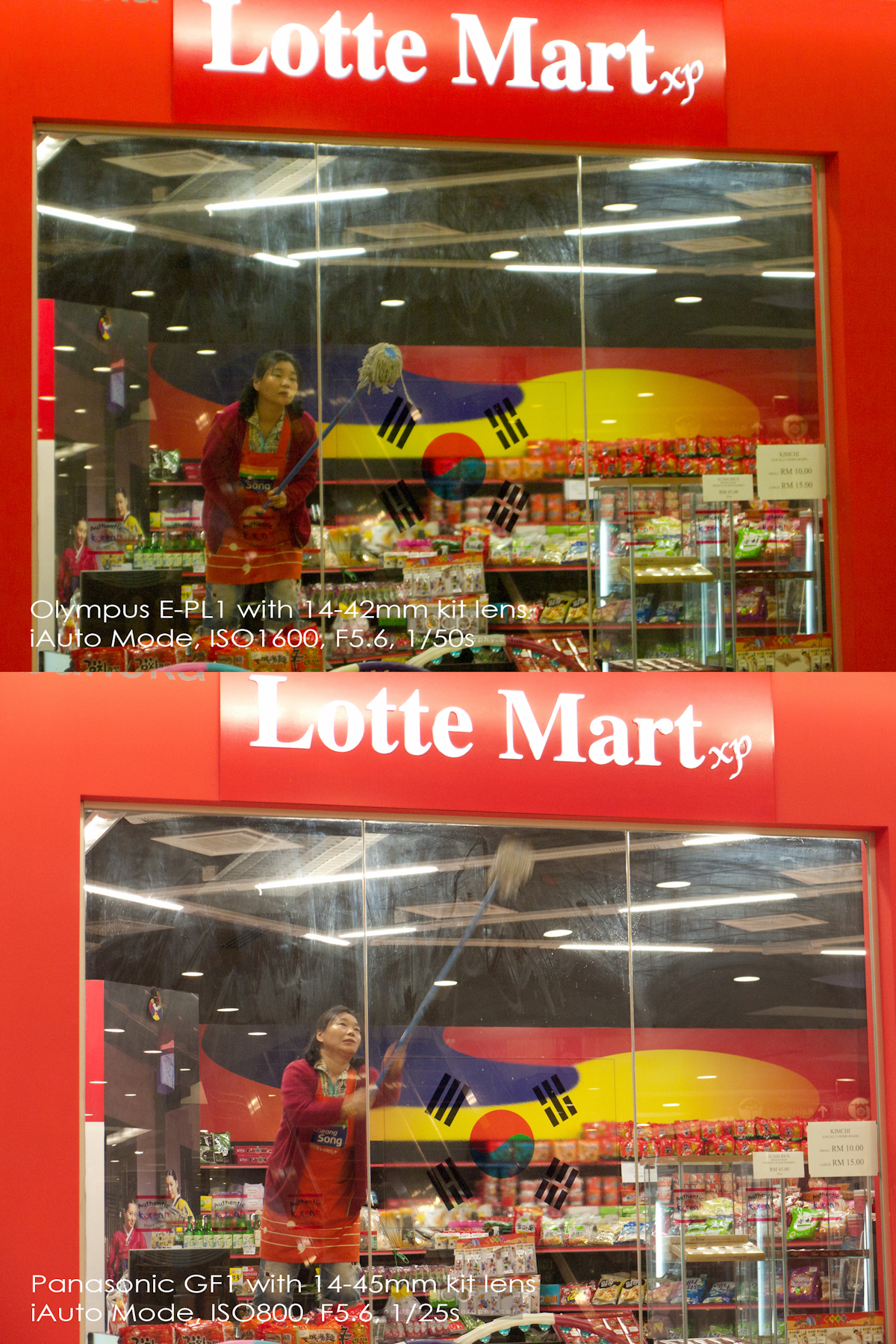
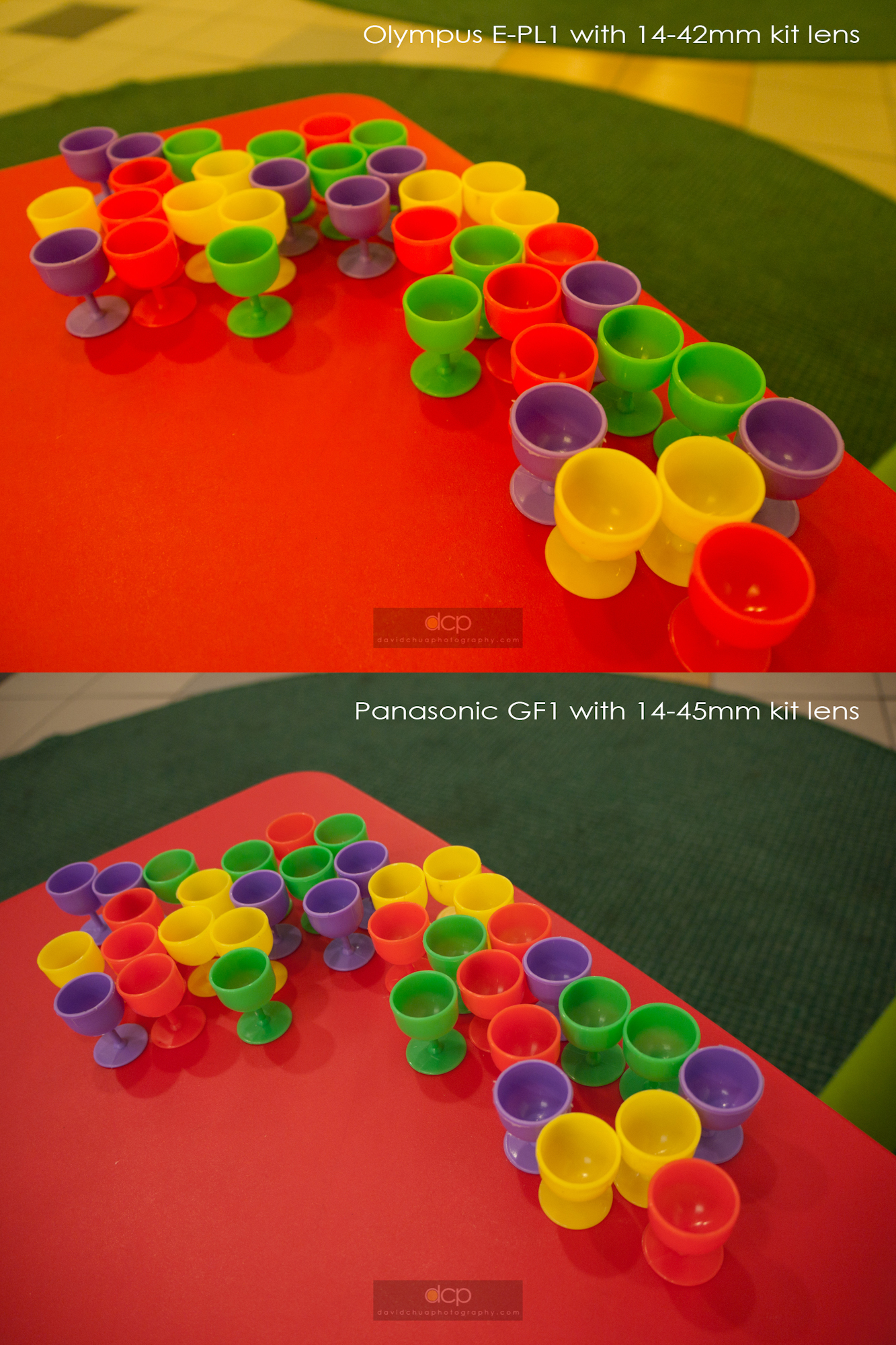


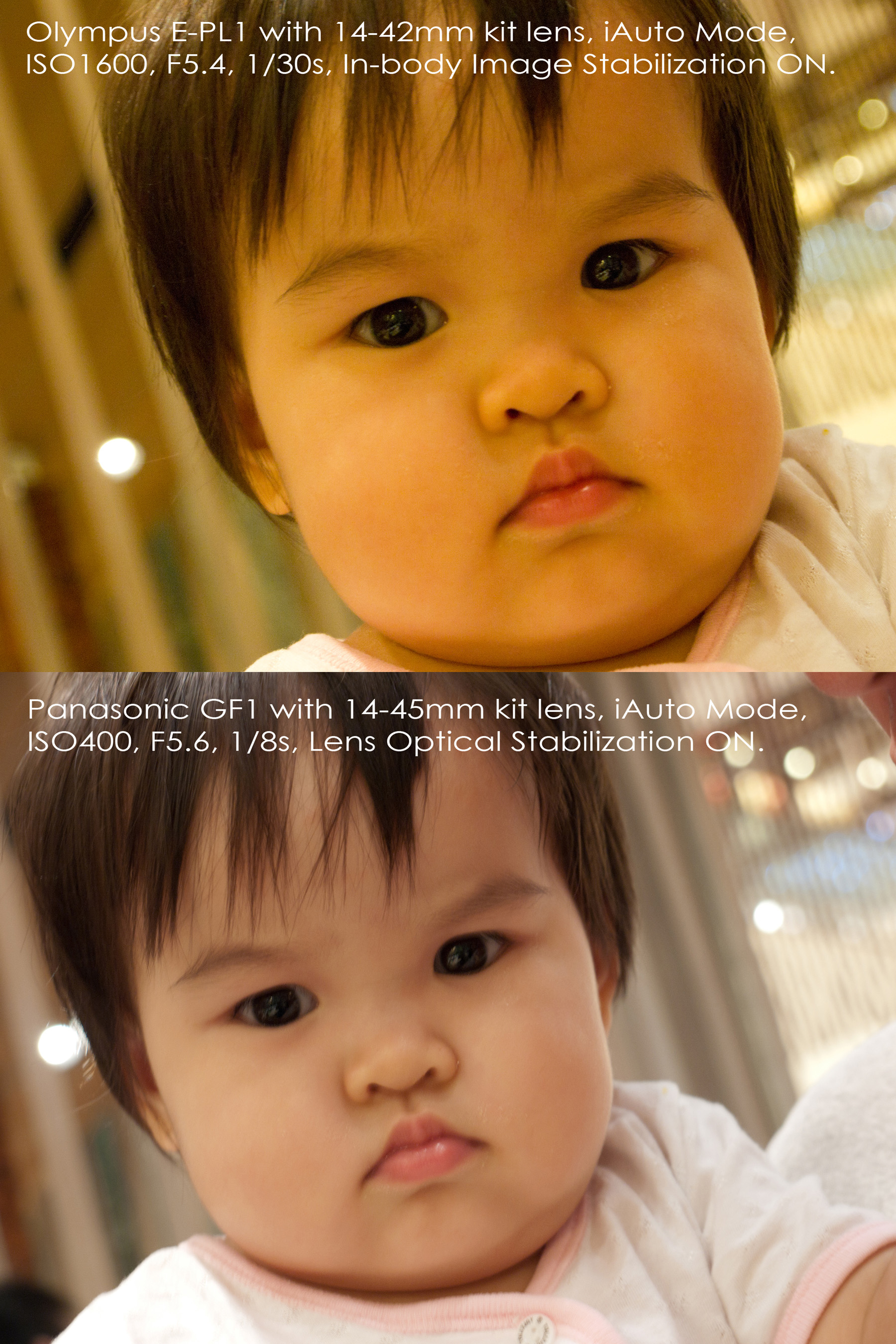
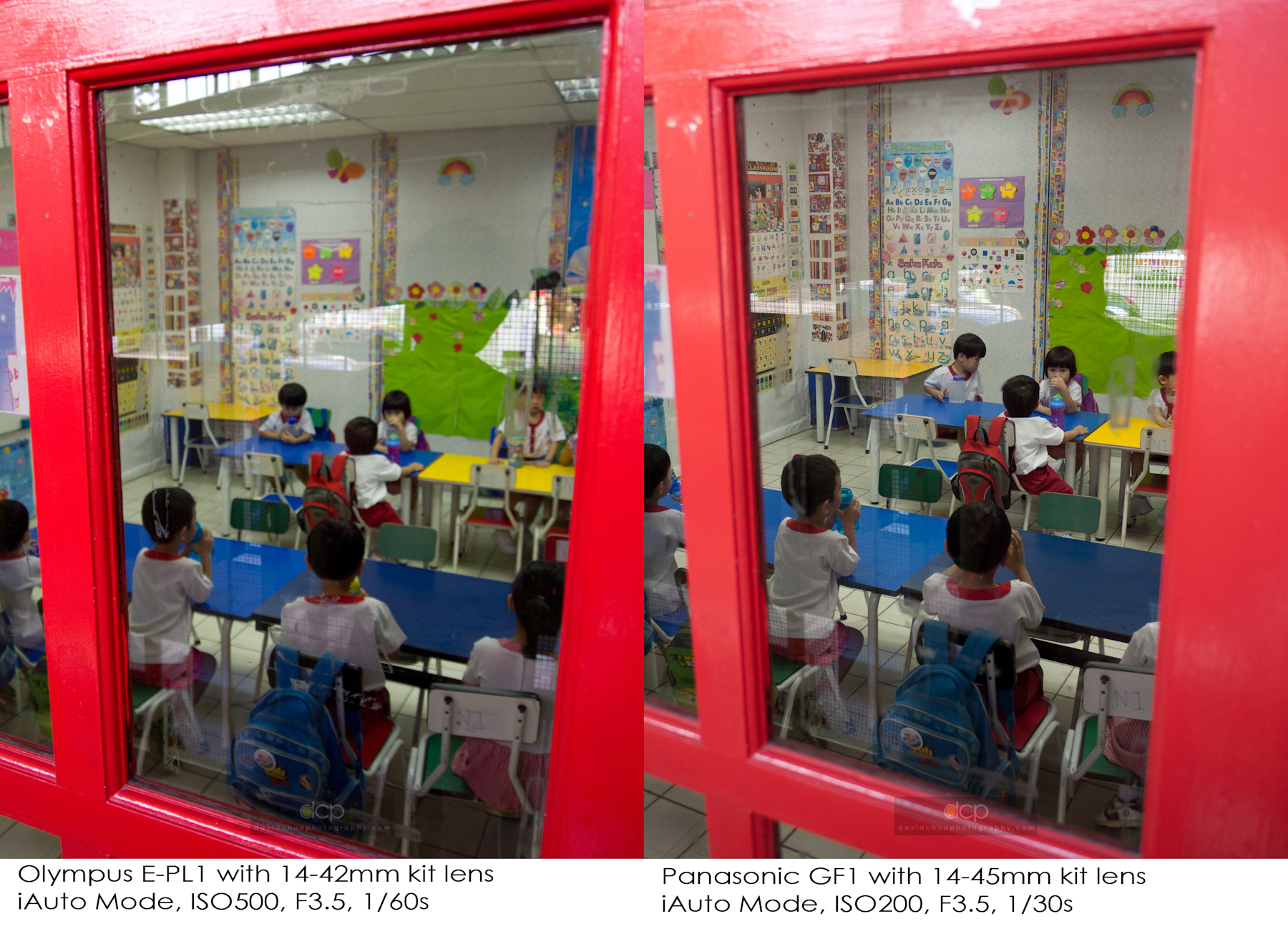

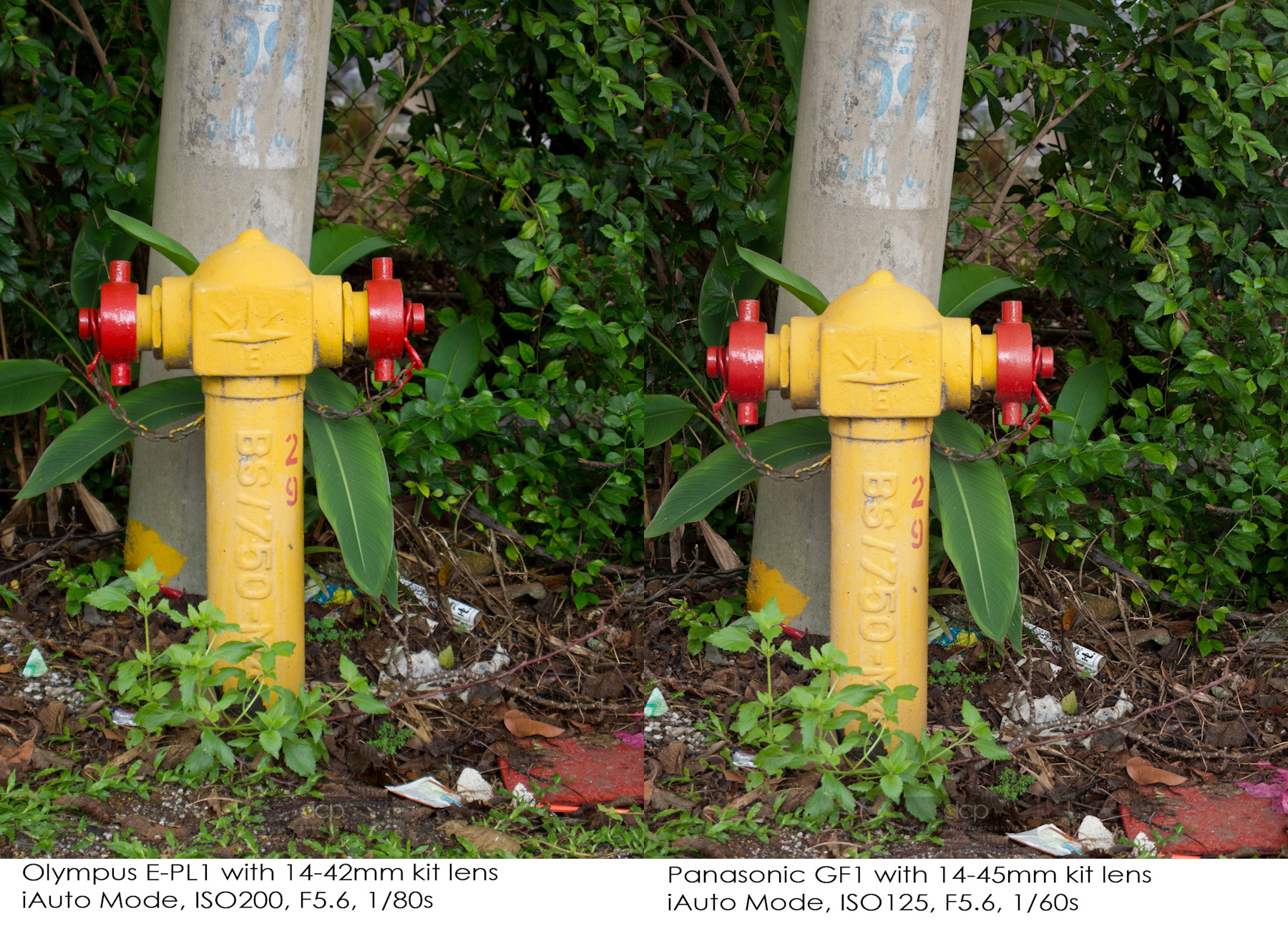
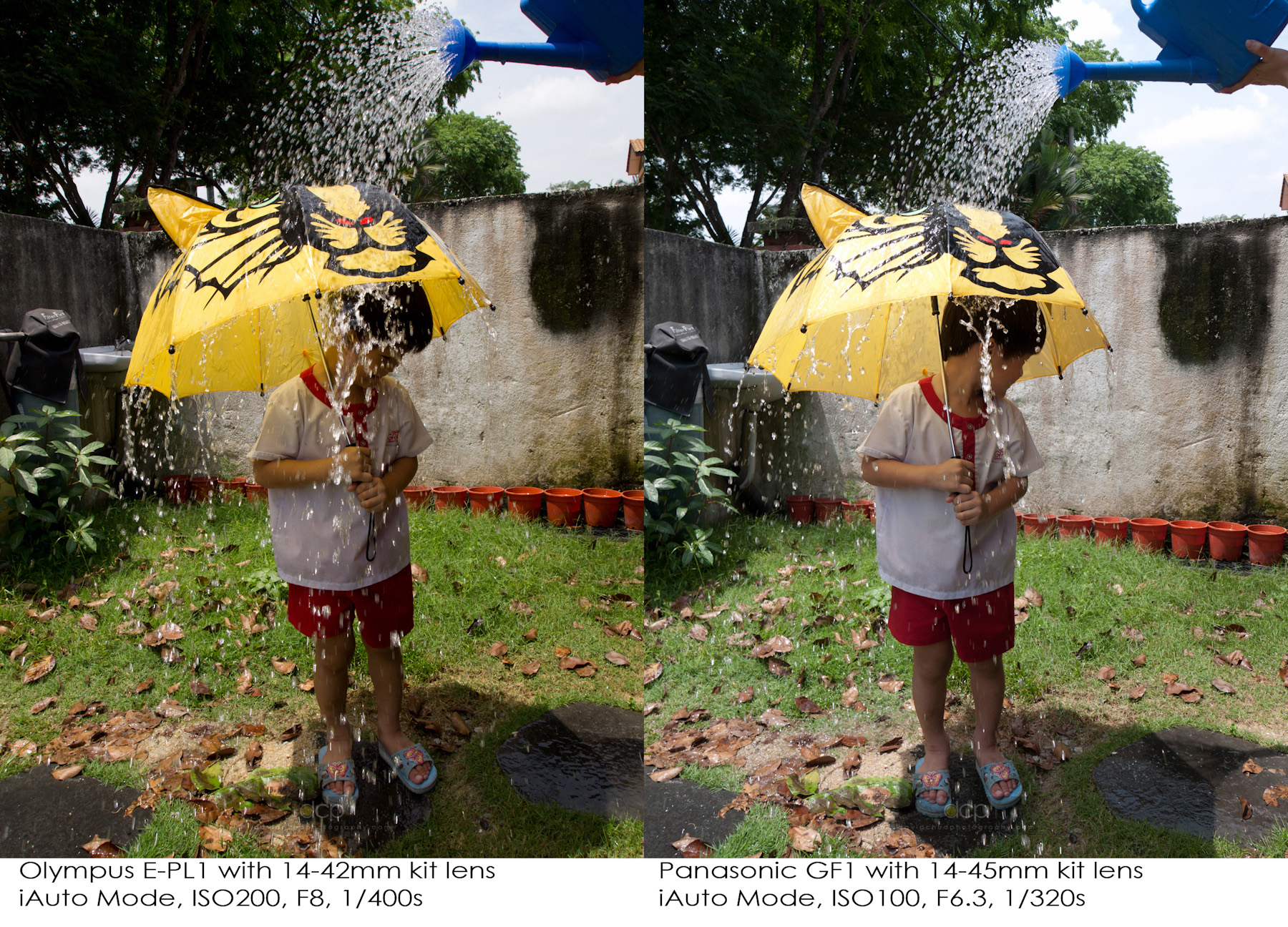

Hi
I have bought a EP 1 last year, i can’t seem to be able to take nice
photographs. Where can i learn the basic use of this camera?
Hi Marine,
If you check out Malaysia’s Olympus Facebook Page, there’re regular workshops conducted at very affordable rates. I believe in Singapore, or other countries, Olympus do the same. Maybe you can check with your country’s Olympus Office?
IMO, the GF-2 doesn’t seem a lot of difference from GF-1. Rumors say the next PEN should be anytime soon, probably within the next couple of months…
It depends whether you wanna wait. Photography is about shooting. If you buy a camera now, you probably will make a few hundreds of stunning images by the time the next PEN is out. You can always sell your camera when you wanna upgrade… sometimes, I treat it as “rental”, so I wouldn’t fuss too much over the “loss”.
The MFT lenses should be readily available in your local photographic stores. If not, you can always try eBay for used ones or online stores like B&H… If you are in Malaysia, you can drop me an email.
thanks for the review… I’m an everyday user that’s planning to get a better camera than the point and shoot camera that I have right now…
One question for you. For your personal opinion, which one should I get the Olympus EPL1 or the Lumix LX5, since it has the Leica lens on it. Thank you.
cheers..
Ardi,
Image quality is a combination of good sensor, good processor and good optics. Leica lens is good, image sensor is smaller and inferior to M43 system: E-PL1(NOT a fair comparison, LX5 is a compact point and shoot), and IMO, Olympus’s image processor processes nicer looking images.
nice article n comparison wise..
now…lumix is out and now i’m considering to buy sony nex5 or epl2..
which 1 better? pls help..
Shawk,
If you want SOOC (straight-out-of-camera) images which require absolute NO TOUCH-UPS, it’s ONLY the E-PL2. (check my flickr). If you want a larger sensor to achieve more shallow depth-of-field effects, it’s the NEX, coupled with FAST manual focus lenses via adapters. The Sony lenses which come with the NEX have quite poor performance as compared to the Panasonic or Olympus M43 lenses. My personal preference goes to using Panny M43 prime lenses (namely 14/2.5, 20/1.7) on E-PL2 if you want AF. At the end of the day, it’s all personal preference. I do like the performance of Leica lenses on the NEX, especially the fast lenses!
Lose the capitalised bold text, and let your text and tone speak for itself – your review reminds me of how people speak to small children!
Can i use Panny lens 20/1.7 on Oly E-PL1?
Hello would you mind stating which blog platform you’re using? I’m going to start my own blog soon but I’m having a difficult time deciding between BlogEngine/Wordpress/B2evolution and Drupal. The reason I ask is because your layout seems different then most blogs and I’m looking for something completely unique. P.S My apologies for being off-topic but I had to ask!
Stargazer, yes, you can.
another great review.
you’re not wrong about cameras not being able to properly capture a red colour and its down to two things. the natural colour of the imaging sensor and red is the colour with the most information.
i.e. if you want to quickly test a camera for low light ability, go for a red backdrop (brochure, shirt etc) and see how grainy the picture comes up) I use this quick test in camera shops for video cameras
Thanks for the review…I have tried the EPL1.It is a perfect camera that produce sharp vivid colors.From my point of view I don’t find the DSLR such as canon 550D better than the EPL1 especially with the new and slim zuiko 9-18 lense.
Hi Expert. I really enjoy reading your Post. I am currently using E-PL1 and having problem taking photos at low light condition. Auto Focus can’t work and there are no AF Lamp on it. Appreciate if you can provide me some guidance or tips. Many Thanks David!
Youre so cool! I dont suppose Ive read anything like this just before. So nice to come across somebody with some original thoughts on this subject. realy thank you for starting this up. this website is one thing that’s needed on the internet, an individual using a small originality. beneficial job for bringing one thing new towards the online!
Hola DCP!
Great blog and assessment. I’ve recently purchased the E-PL1 for a great price and I too am having the same problem as user C K Tan. In low light conditions the focus does not catch on and even in perfect view (as perfect as the view can seem from the led screen) it will not snap a picture. I’ve also noticed that aperture and shutter speed really does not help much. Another problem is that in lower light conditions the more you want to zoom in on an object the less likely the camera will allow the picture to be taken. Any help/advice would be greatly appreciated!
Keep up the great work!
Hi Dino,
The best you could do with the E-PL1 in low light would be… if you are using the 14-42mm zoom, try AF at 14mm, F3.5 (widest aperture). Remember you can’t AF nearer than 25cm to the subject due to the minimum focus distance of the lens. If you are using the Lumix 20mm F1.7, you may find it slightly easier to achieve AF when used at F1.7 (due to the larger aperture). Usually, when you can’t achieve AF at all, it’s either you are too near to the subject or it’s really too dark… in which given the Nikon or Canon in LiveView mode would probably also NOT be able to achieve AF. IMO.
Hi DCP,
I just recently purchased a Panasonic GF1 with 20mm f1.7 lens, I would say that this camera rocks! I’ve read your review im just curious if u had any issues with the Panasonic GF1 using it under bright sunlight? My LCD screen flashes when i try to autofocus under bright sunlight. I will have to turn-off and then on the cam for me to focus again without LCD flashes. I’m not sure if this is normal.
Thanks
hello,
i’m an old argentic photographier;i’ve professionnal camera all in function!!
instead of buying a numeric mamiya back so expensive!!!i choose to put and old jupiter 8 2:50mm on body camera numeric; but each choice to do? after reading this notes, it could be the olympus E PL1 the better choice for color, intelligence of capteur, is it all manuel function possibility?
now i hesitate beetween both olympus and lumix gf1,2; for the same price actually on ebay!!
for each choice can you give me professional advice, and what is the adaptator to put on for lens, where buying it very efficiently? thank you;clakos
magnificent publish, very informative. I ponder why the other specialists of this sector do not notice this. You should continue your writing. I am sure, you’ve a huge readers’ base already!
its year 2012. And the Olympus XZ-1 has been in the market for a year now.
i wonder aloud: would an Olympus XZ-1 with an aperture starting at f/1.8 produce a better picture than an Olympus PEN E-PL2 with a kit zoom lens of 14-42mm with standard aperture range of f/3.5-5.8?
yes, the PL-2 has a biggger sensor size than the XZ-1, but it cannot come close to the f/1.8 aperture available to the XZ-1.
so the question is: will a bigger sensor deliver a better/sharper/clearer picture despite having a zoom lens with standard aperture range of f/3.5-5.8 versus that of the f/1.8 in the XZ-1?
would anyone care to know?
Way сool! Some very valid points! I appreciate you penning this post and the rest οf the website is
really good.
I read your blog. I am interested your blog. Thanks a lot.